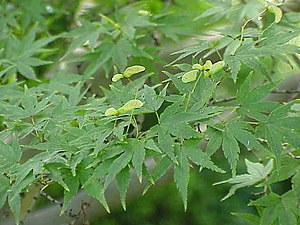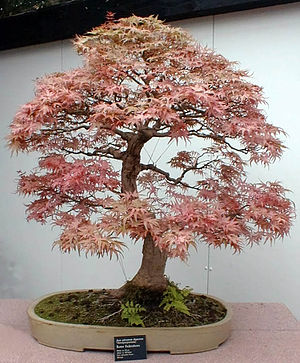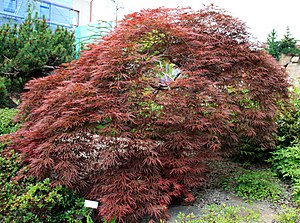Japanese maple
| Japanese maple | ||||||||||||
|---|---|---|---|---|---|---|---|---|---|---|---|---|

Japanese maple ( Acer palmatum ) |
||||||||||||
| Systematics | ||||||||||||
|
||||||||||||
| Scientific name | ||||||||||||
| Acer palmatum | ||||||||||||
| Thunb. |
The Japanese maple ( Acer palmatum ) belongs to the maple genus . The green Japanese maple, originally from Japan , Korea and China , has a height of up to 15 meters. The name is derived from the Latin 'palma' ("palm") and refers to the leaf shape of the plant.
description
The green Japanese maple grows broadly bushy with umbrella-like inclined branches. The opposite leaves are split into five to eleven pointed lobes deep below the middle. The edges of the lobes are serrated. The leaves are up to 20 centimeters in size. The bark of the tree is dark brown and smooth in young wood, but turns light gray with increasing age and the formation of bark .
The flower clusters have 5 petals and are formed in May to June. The genus counts up to 150 different species, with the varieties one counts about 500. While the maple can grow into large trees in its homeland, this is rather rare in specimens and varieties imported to Europe and takes a very long time. The reason for this is the overall cooler and drier climate in Europe, combined with shorter growing seasons. It blooms from May to June with red, later brown flower clusters .
The fruits are decayed fruits and split into two seeds, each with a "wing".
The number of chromosomes is 2n = 26.
Occurrence
The Japanese maple thrives best in a sunny to partially shaded location. The plant prefers loose and humus soils with good drainage and a slightly acidic pH . Waterlogging very quickly leads to the death of the fine roots due to a lack of oxygen. The shoot is yellowish to bright red, depending on the variety. The same applies to the very intense autumn colors.
Ornamental plant
The Japanese maple is mainly used and valued as an ornamental plant in Europe. The reasons for this are mostly due to the delicate shape and the intense autumn color. In Japan it is the most important tree in traditional garden design and heralds autumn. Primarily the original green varieties are planted there. It is also widely used in bonsai art . This connection also resulted in many cultivated varieties that meet the requirements. Depending on the variety, the leaves have more fingers, are more slit, have a different color (sometimes only at certain times of the year) or the bark is rougher than usual. Often several features are also combined. There is a system for the varieties that explicitly classifies them into categories.
The propagation of these cultivars is difficult because it is not possible to use seeds as a single variety. When sowing, you get 50–90% normal, green Japanese maple, the rest are all possible varieties. In the commercial sector, ordinary green Japanese maple is sown, onto which branches of a mother plant are then grafted . Regardless of this, it is possible to obtain single-variety plants through vegetative propagation .
cut

The Japanese maple has the reputation of not tolerating pruning particularly well. When making a purchase, you will often find indications that you should avoid cutting. However, this is only partially the case and its great popularity with bonsai designers clearly speaks against it. After all, when designing bonsai, plants are regularly cut and, in some cases, kept in their shape for centuries and refined. However, the cut requires more care than with other plants, as the Japanese maple does not allow new shoots to grow out of the old wood. You have to remember that - although the Japanese maple in Europe is often hardly bigger than a shrub - it is a tree after all. It is correspondingly difficult for him to replace branches that have been completely removed down to the trunk. It is best to always leave some young wood with sleeping eyes on the plant so that new shoots can take place. However, you should not cut too tightly, as the maple always dries back a little to protect itself, which could also affect sleeping eyes . When cutting, you cut back on young side shoots, then you should apply a wound closure agent. The best for this are Japanese, which you can get in bonsai shops. The regular ones like lac balms are useless and even harm the tree. The wound closes particularly quickly if there is a vital branch above it. The flow of building material directed downwards from there promotes wound callus formation and helps to close the wound quickly. When creating a bonsai, the tip of the shoot is always removed from a certain degree of maturity in order to promote fine branching when all leaves are sprouting again. This stimulates the maple to wake dormant buds. It then forms shorter leaf gaps and smaller leaves, two things that are elementary when designing a bonsai. At the same time, it slows down the tree's growth.
Cultivated forms
- 'Arakawa' ( cork bark maple): The bark is barky. The freshly sprouted leaves are light green and later turn green. The autumn color is pronounced.
- 'Atropurpureum' (also called red-leaved Japanese maple): The fresh leaves in spring have a dark purple color and fade to a reddish green in summer. It turns dark scarlet in autumn. The tree is 6 m to 7.50 m high and has a semicircular to round crown.

- 'Beni komachi': The name of the variety means red, beautiful little girl . It is a dwarf form. It has bright red leaves that darken in color as the year progresses and turn scarlet in autumn.
- 'Bloodgood': tree up to 6 m high with a particularly strong red autumn color.
- 'Dissectum': slit leaves.
- 'Katsura' has wavy, greenish-reddish leaves on the edge. The autumn color is yellow and orange.
- 'Kiyohime' has very small leaves. The autumn color is yellow.
- 'Koshimino': tree up to 6 m high with stemless leaves.
- 'Orange Dream' has bright green, deeply cut foliage. The fresh leaves are orange and the autumn colors are yellow.
- 'Osakazuki' has green leaves that are 5 to 10 cm wide and are bright red in autumn.
- 'Sango kaku' has coral red bark.
- 'Shishigashira' has a very compact, stocky growth. The green leaves are wrinkled. The autumn color is yellow.
literature
- JD Vertrees: Japanese Maples. (Original title: Japanese Maples ). German by Marion Zerbst. Ulmer, Stuttgart 1993, ISBN 3-8001-6444-2 .
- Peter Adams: Bonsai with Japanese Maples. Timber Press, Portland 2006, ISBN 0-88192-809-7 .
Web links
- Thomas Meyer: Data sheet with identification key and photos at Flora-de: Flora von Deutschland (old name of the website: Flowers in Swabia )
- Literature on Acer palmatum in the Kew Bibliographic Databases (English)
Individual evidence
- ↑ Peter Adams: Bonsai with Japanese Maples , p. 11.
- ↑ a b Horst Stahl: Bonsai - From the basic course to the master . Double volume, Kosmos Verlag, Stuttgart 1992, p. 20, ISBN 3-440-08875-8 .
- ↑ Acer palmatum - Japanese maple - tree portrait
- ↑ Acer palmatum at Tropicos.org. In: IPCN Chromosome Reports . Missouri Botanical Garden, St. Louis
- ↑ Acer palmatum (Japanese maple). Archived from the original on 20161024 ; Retrieved November 11, 2009 .
- ↑ Jean-Paul Pigeat: Gardens in Japan style
- ↑ JD Vertrees: Japanese Maples
- ↑ Tree portrait: acer palmatum
- ↑ Acer palmatum as a bonsai
- ↑ a b c d e Japanese Maples at the JC Raulston Arboretum
- ↑ University of Illinois: Acer palmatum var. Atropurpureum - Purple-leaved Japanese maple
- ↑ Urban Forest Ecosystems Institute: Red japanese maple at the College of Agriculture of the California of the Polytechnic State University in San Luis Obispo, California.
- ↑ a b c Family home and garden: A firework of colors: maple
- ↑ Urban Forest Ecosystems Institute: Bloodgood japanese maple at the College of Agriculture of California at Polytechnic State University in San Luis Obispo, California.
- ^ A b NC State University: Acer palmatum Cultivars. Archived from the original on November 19, 2013 ; Retrieved March 27, 2010 .
- ↑ Quailhollow gardens: Acer palatum Koshimino
- ↑ a b My beautiful garden: Garden wiki: Japanese maple
- ↑ Urban Forest Ecosystems Institute: Coral bark japanese maple at the College of Agriculture of California at Polytechnic State University in San Luis Obispo, California.
- ↑ NC state university: Acer palmatum 'Sango-kaku'
- ↑ Maple Ridge Nursery: Acer palmatum 'Shishigashira ( Memento of the original from April 28, 2017 in the Internet Archive ) Info: The archive link was inserted automatically and has not yet been checked. Please check the original and archive link according to the instructions and then remove this notice.
- ↑ University of Hohenheim - Landesarboretum database ( Memento of the original dated May 24, 2011 in the Internet Archive ) Info: The archive link was inserted automatically and has not yet been checked. Please check the original and archive link according to the instructions and then remove this notice.

